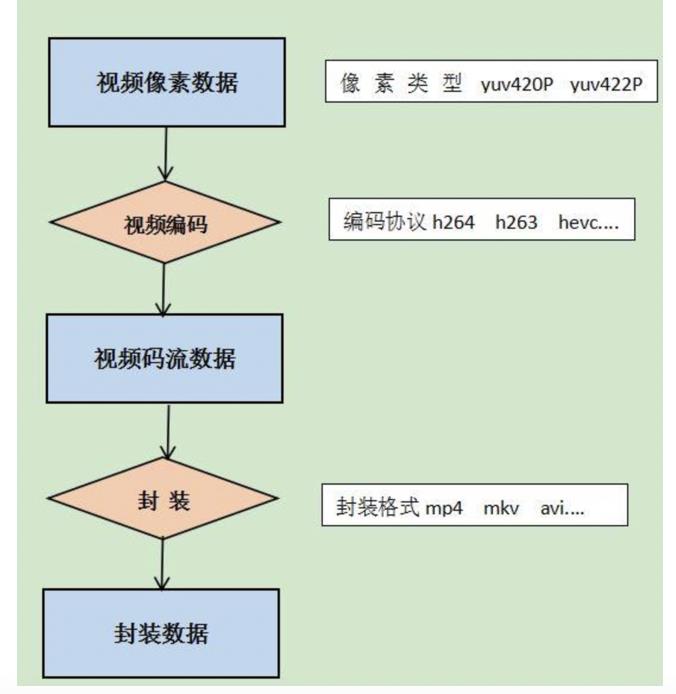基于FFmpeg将pcm+rgb编码并封装MP4
Posted 老樊Lu码
tags:
篇首语:本文由小常识网(cha138.com)小编为大家整理,主要介绍了基于FFmpeg将pcm+rgb编码并封装MP4相关的知识,希望对你有一定的参考价值。
FFmpeg是非常强大好用的音视频处理库,功能强大,首先我们先说说如何配置使用FFmpeg。
首先,从官网上下载:
FFmpeg官提供了3个版本:Static,Shared,Dev。介绍如下:
前两个版本可以直接在命令行中使用,他们的区别在于:
Static里面只有3个应用程序:ffmpeg.exe,ffplay.exe,ffprobe.exe,每个exe的体积都很大,相关的Dll已经被编译到exe里面去了。
Shared里面除了3个应用程序:ffmpeg.exe,ffplay.exe,ffprobe.exe之外,还有一些Dll,比如说avcodec-54.dll之类的。Shared里面的exe体积很小,他们在运行的时候,到相应的Dll中调用功能。
Dev版本是用于开发的,里面包含了include(头文件xxx.h)和lib(库文件xxx.lib),这个版本不包含exe文件。
在vs使用和一般的库包一样只要把Dev版本下的include文件添加到包含目录,lib文件夹下的lib文件添加到附加依赖性项中。不要忘记在环境变量中添加bin目录。bin文件夹位于Shared版本里面。
简单实用FFmpeg把YUV的数据经过H264编码为视频码流,再封装成Mp4。
FFmpeg编码流程:
(1).首先使用av_register_all()函数注册所有的编码器和复用器(理解为格式封装器)。该步骤必须放在所有ffmpeg代码前第一个执行
(2). avformat_alloc_output_context2():初始化包含有输出码流(AVStream)和解复用器(AVInputFormat)的AVFormatContext avio_open( )打开输出文件
(3).av_new_stream() 创建视频码流 该函数生成一个空AVstream 该结构存放编码后的视频码流 。视频码流被拆分为AVPacket新式保存在AVStream中。
(4).设置编码器信息,该步骤主要是为AVCodecContext(从AVStream->codec 获取指针)结构体设置一些参数,包括codec_id、codec_type、width、height、pix_fmt ..... 根据编码器的不同,还要额外设置一些参数(如 h264 要设置qmax、qmin、qcompress参数才能正常使用h264编码)
(5).查找并打开编码器,根据前一步设置的编码器参数信息,来查找初始化一个编码其,并将其打开。用到函数为av_fine_encoder()和av_open2()。
(6).写头文件 avformat_write_header()。这一步主要是将封装格式的信息写入文件头部位置。
(7).编码帧。用到的函数 avcodec_encode_video2() 将AVFrame编码为AVPacket
(8).在写入文件之前 还需要做一件事情就是设置AVPacket一些信息。这些信息关乎最后封装格式能否被正确读取。后面回详细讲述该部分内容
(9).编码帧写入文件 av_write_frame()
(10).flush_encoder():输入的像素数据读取完成后调用此函数。用于输出编码器中剩余的AVPacket。
(11).av_write_trailer():写文件尾(对于某些没有文件头的封装格式,不需要此函数。比如说MPEG2TS)

extern "C"
#include <libavcodec/avcodec.h>
#include <libavformat/avformat.h>
#include <libavutil/avutil.h>
#include <libswscale/swscale.h>
using namespace std;
int flush_encoder(AVFormatContext *fmt_ctx,unsigned int stream_index);
int main(int argc, char *argv[])
AVFormatContext *pFormatCtx=nullptr;
AVOutputFormat *fmt=nullptr;
AVStream *video_st=nullptr;
AVCodecContext *pCodecCtx=nullptr;
AVCodec *pCodec=nullptr;
uint8_t *picture_buf=nullptr;
AVFrame *picture=nullptr;
int size;
//打开视频
FILE *in_file = fopen("F://src01_480x272.yuv", "rb");
if(!in_file)
cout<<"can not open file!"<<endl;
return -1;
int in_w=480,in_h=272;
int framenum=50;
const char* out_file="src01.mp4";
//[1] --注册所有ffmpeg组件
avcodec_register_all();
av_register_all();
//[1]
//[2] --初始化AVFormatContext结构体,根据文件名获取到合适的封装格式
avformat_alloc_output_context2(&pFormatCtx,NULL,NULL,out_file);
fmt = pFormatCtx->oformat;
//[2]
//[3] --打开文件
if(avio_open(&pFormatCtx->pb,out_file,AVIO_FLAG_READ_WRITE))
cout<<"output file open fail!";
goto end;
//[3]
//[4] --初始化视频码流
video_st = avformat_new_stream(pFormatCtx,0);
if(video_st==NULL)
printf("failed allocating output stram\\n");
goto end;
video_st->time_base.num = 1;
video_st->time_base.den =25;
//[4]
//[5] --编码器Context设置参数
pCodecCtx = video_st->codec;
pCodecCtx->codec_id = fmt->video_codec;
pCodecCtx->codec_type = AVMEDIA_TYPE_VIDEO;
pCodecCtx->pix_fmt = AV_PIX_FMT_YUV420P;
pCodecCtx->width=in_w;
pCodecCtx->height=in_h;
pCodecCtx->time_base.num = 1;
pCodecCtx->time_base.den = 25;
pCodecCtx->bit_rate = 400000;
pCodecCtx->gop_size = 12;
if(pCodecCtx->codec_id == AV_CODEC_ID_H264)
pCodecCtx->qmin = 10;
pCodecCtx->qmax = 51;
pCodecCtx->qcompress = 0.6;
if (pCodecCtx->codec_id == AV_CODEC_ID_MPEG2VIDEO)
pCodecCtx->max_b_frames = 2;
if (pCodecCtx->codec_id == AV_CODEC_ID_MPEG1VIDEO)
pCodecCtx->mb_decision = 2;
//[5]
//[6] --寻找编码器并打开编码器
pCodec = avcodec_find_encoder(pCodecCtx->codec_id);
if(!pCodec)
cout<<"no right encoder!"<<endl;
goto end;
if(avcodec_open2(pCodecCtx,pCodec,NULL)<0)
cout<<"open encoder fail!"<<endl;
goto end;
//[6]
//输出格式信息
av_dump_format(pFormatCtx,0,out_file,1);
//初始化帧
picture = av_frame_alloc();
picture->width=pCodecCtx->width;
picture->height=pCodecCtx->height;
picture->format=pCodecCtx->pix_fmt;
size = avpicture_get_size(pCodecCtx->pix_fmt,pCodecCtx->width,pCodecCtx->height);
picture_buf = (uint8_t*)av_malloc(size);
avpicture_fill((AVPicture*)picture,picture_buf,pCodecCtx->pix_fmt,pCodecCtx->width,pCodecCtx->height);
//[7] --写头文件
avformat_write_header(pFormatCtx,NULL);
//[7]
AVPacket pkt; //创建已编码帧
int y_size = pCodecCtx->width*pCodecCtx->height;
av_new_packet(&pkt,size*3);
//[8] --循环编码每一帧
for(int i=0;i<framenum;i++)
//读入YUV
if(fread(picture_buf,1,y_size*3/2,in_file)<0)
cout<<"read file fail!"<<endl;
goto end;
else if(feof(in_file))
break;
picture->data[0] = picture_buf; //亮度Y
picture->data[1] = picture_buf+y_size; //U
picture->data[2] = picture_buf+y_size*5/4; //V
//AVFrame PTS
picture->pts=i;
int got_picture = 0;
//编码
int ret = avcodec_encode_video2(pCodecCtx,&pkt,picture,&got_picture);
if(ret<0)
cout<<"encoder fail!"<<endl;
goto end;
if(got_picture == 1)
cout<<"encoder success!"<<endl;
// parpare packet for muxing
pkt.stream_index = video_st->index;
av_packet_rescale_ts(&pkt, pCodecCtx->time_base, video_st->time_base);
pkt.pos = -1;
ret = av_interleaved_write_frame(pFormatCtx,&pkt);
av_free_packet(&pkt);
//[8]
//[9] --Flush encoder
int ret = flush_encoder(pFormatCtx,0);
if(ret < 0)
cout<<"flushing encoder failed!"<<endl;
goto end;
//[9]
//[10] --写文件尾
av_write_trailer(pFormatCtx);
//[10]
end:
//释放内存
if(video_st)
avcodec_close(video_st->codec);
av_free(picture);
av_free(picture_buf);
if(pFormatCtx)
avio_close(pFormatCtx->pb);
avformat_free_context(pFormatCtx);
fclose(in_file);
return 0;
int flush_encoder(AVFormatContext *fmt_ctx,unsigned int stream_index)
int ret;
int got_frame;
AVPacket enc_pkt;
if (!(fmt_ctx->streams[stream_index]->codec->codec->capabilities &
CODEC_CAP_DELAY))
return 0;
while (1)
printf("Flushing stream #%u encoder\\n", stream_index);
enc_pkt.data = NULL;
enc_pkt.size = 0;
av_init_packet(&enc_pkt);
ret = avcodec_encode_video2 (fmt_ctx->streams[stream_index]->codec, &enc_pkt,
NULL, &got_frame);
av_frame_free(NULL);
if (ret < 0)
break;
if (!got_frame)
ret=0;break;
cout<<"success encoder 1 frame"<<endl;
// parpare packet for muxing
enc_pkt.stream_index = stream_index;
av_packet_rescale_ts(&enc_pkt,
fmt_ctx->streams[stream_index]->codec->time_base,
fmt_ctx->streams[stream_index]->time_base);
ret = av_interleaved_write_frame(fmt_ctx, &enc_pkt);
if (ret < 0)
break;
return ret;
在步骤9中已说明要完成最后的格式封装(mux),需要对AVPacket的参数进行设置。具体设置项如下:
// parpare packet for muxing
enc_pkt.stream_index = stream_index;
av_packet_rescale_ts(&enc_pkt,
fmt_ctx->streams[stream_index]->codec->time_base,
fmt_ctx->streams[stream_index]->time_base);
包括设置AVPacket所属的码流index,
2、将pts(显示时间戳)和dts(编码时间戳)和duration(nextpts - curpts)按照不同time_base(时间基准)进行转换。
以上是关于基于FFmpeg将pcm+rgb编码并封装MP4的主要内容,如果未能解决你的问题,请参考以下文章